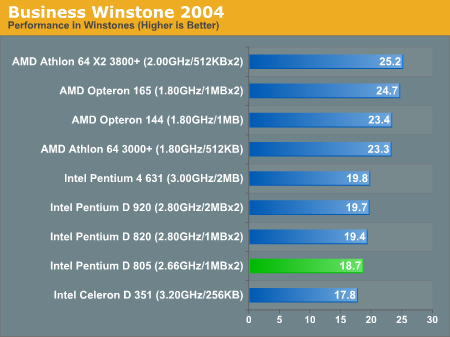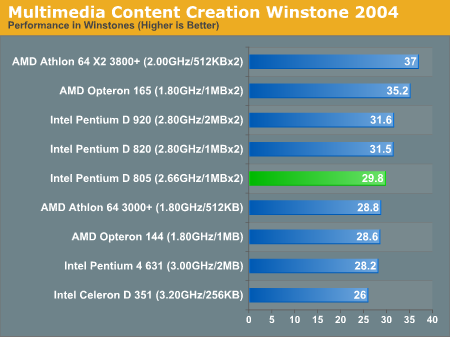Intel Pentium D 805 - Dual Core on a Budget
by Anand Lal Shimpi on April 7, 2006 12:00 AM EST- Posted in
- CPUs
Overall Performance using Winstone 2004

Business Winstone and business applications in general have hardly been a strong point of Intel's NetBurst architecture. The Pentium D 805, along with its brethren, fall to the bottom of the chart. The 805 actually only loses about 4% of the performance of the Pentium D 820, but if single task office applications are all you'll be using you are much better off with the single core Athlon 64 3000+. Even with light multitasking thrown in (as the Business Winstone suite tests), you're still better off with the Athlon 64. You will however lose some of the increase in responsiveness that a dual core CPU will afford you, as dual core CPUs can help mask much of the impact of poor scheduling by Windows when multitasking.

The picture changes a bit when you toss some 3D rendering and more multimedia centric applications into the mix. Now the Pentium D 805 offers better performance than the Athlon 64 3000+, while giving you the more tangible but not easily quantifiable benefits of a dual core CPU.
As the tasks become more intense, the higher clock and faster FSB of the Pentium D 820 become more important; here the Pentium D 820 holds close to a 6% advantage over the 805. Of course at the top of the charts are the Opteron 165 and Athlon 64 X2 3800+, but at more than twice the price of the Pentium D 805 you would expect no less.










51 Comments
View All Comments
peternelson - Sunday, April 9, 2006 - link
Thanks Jack, that PCN was exactly what I needed.
I had previously looked through the Intel site but not found it myself.
Given that the physical changes were only "add 10 resistors and 2 capacitors", I wonder whether Gigabyte, Asus etc al will be modding their 975 board. Heard rumours about Asus but that their new ones won't be shipping until July? No news on Gigabyte.
Viditor - Sunday, April 9, 2006 - link
Great info...thanks Jack!xxtypersxx - Friday, April 7, 2006 - link
Well I am running an opteron 165 @2.6 ghz on a 1.45vcore, and I'd say its definately worth it. And that information is blatantly wrong, as the 3800+ runs at 1.8ghz stock, same as the 165
JarredWalton - Friday, April 7, 2006 - link
No, the X2 4200+ is a 2.2 GHz 512K part, the 3800+ is a 2.0 GHz 512K part, and the Opteron 170 is also a 2.0 GHz part but with 1024K. The 165 is definitely 200 MHz slower than the X2 3800+. Now, as for your quote, finish the paragraph:(Overclocking makes things a bit more interesting, naturally.)
This is not an overclocking article, and if you're not going to overclock then there is absolutely no reason to spend $20 more for the Opteron 165 only to get slightly slower performance. The added cache gives a 3-5% performance boost at the same clock speed; the added 200 MHz accounts for an 11% performance boost in CPU power. It's not too difficult to see which is larger.
That said, I have two X2 3800+ chips and an Opteron 165. The X2 chips hit 2.60 GHz, and the Opteron 165 hits about the same speed. The retail Opteron HSF is definitely better, but for serious overclocking you'd probably want to spend another $50 on an aftermarket HSF anyway. Is the Opteron 165 a bad purchase? No. It's also not the greatest thing ever to hit the planet. If I were to rate the X2 3800+ vs. the Opty 165, I have to call it a tie. Both are great chips, both overclock well, and both reach very near the same final performance levels in my experience.
Kougar - Friday, April 7, 2006 - link
I've really been wanting a good definite article on ALL of these proccessors! Thank you very much! This is so handy to have as a reference when people want to know what to go with for what application/purpose. I am very much looking forward to that overclocking article, it'd be very neat to see all of these processors in it ;) Can finally see how much of the hype about Opterons is grounded in fact!When prices on both the 800 and 900 series plummet to next to NOTHING within several months for Conroe (http://www.dailytech.com/article.aspx?newsid=1619">LINK), this will be handy to know. Hopefully AMD will focus on fully converting over to 300mm and 65nm processes quickly to help lower their marginal costs and therefore their own retail prices.
I did think it was rather sad to see the day when a Celeron D was fairly competetive or outright winning against a Athlon 64 3000+ though, excluding games... Guess that was just me!
artifex - Friday, April 7, 2006 - link
Please include Mersenne Prime and/or distributed.net keycracking in your testing suite :)No, seriously, each has short benchmarks to run. And these "temporary" machines will need something to do after we all upgrade again in a few months.
Googer - Friday, April 7, 2006 - link
I thought Conroe was going to run only on a 975 Chipset and early chipsets produced by Intel has a design mistake that needed to be reivised. So early spec 975 motherboards were indended to run conroe but will not, you will need a revion 2 board/chipset.
JarredWalton - Friday, April 7, 2006 - link
We're not saying you can upgrade from 805 to Conroe with the same motherboard. We're saying that for about $230 you can get a reasonable socket 775 motherboard and a PD 805 and it should handle all of your multithreaded computing needs until the AM2/Conroe launches.975X support for Conroe is still a bit unknown - I'm not sure if early 975X boards will work, and I don't even know that all current 975X boards will work. 945 *won't* work as far as I know, as 965 will be the "value" platform for Conroe processors.
hoppa - Friday, April 7, 2006 - link
I was very tempted until I saw those power ratings.... yikes.kyparrish - Friday, April 7, 2006 - link
This is the kind of article we all love reading, one that's well-detailed and concise.